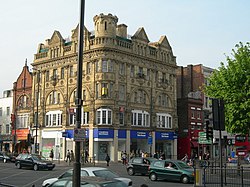Holloway
| Holloway | |
| Middlesex | |
|---|---|
 Holloway Road and Seven Sisters Road, Holloway | |
| Location | |
| Grid reference: | TQ306859 |
| Location: | 51°33’25"N, 0°7’2"W |
| Data | |
| Post town: | London |
| Postcode: | N7, N19 |
| Dialling code: | 020 |
| Local Government | |
| Council: | Islington |
| Parliamentary constituency: |
Islington South and Finsbury / Islington North |
Holloway is an inner-city area or urban village of Middlesex, strewn along the line of the Holloway Road (the A1) north of the City of London. It is immediately west of Highbury and north-east of Camden Town. At the centre of Holloway is the Nag's Head commercial area, which sits between the more residential Upper Holloway and Lower Holloway neighbourhoods.
Holloway has a multicultural population. It is the home of Arsenal F.C. It was home to the largest women's prison in Europe, Holloway Prison, until 2016.
History
The origins of the name are disputed; some believe that it derives from Hollow, or Hollow way (a sunken lane), due to a dip in the road caused by the passage of animals and water erosion, as this was the main cattle driving route from the north into Smithfield. In Lower Holloway, the former Back Road, now Liverpool Road was used to rest and graze the cattle before entering London. Others believe the name derives from Hallow and refers to the road's historic significance as part of the pilgrimage route to Walsingham. No documentary evidence can be found to support either derivation.[1] By 1307, the name Holwey was applied to the district around the road.[2]
The main stretch of Holloway Road runs through the site of the former villages of Tollington and Stroud. The exact time of their founding is not known, but the earliest record of them dates from the Domesday Book. The names ceased to be used by the late 17th century, but are still preserved in the local place names Tollington Park and Stroud Green.[1]
The original route, from London, led through Tollington Lane, but such was the state of this road by the 14th century, that the Bishop of London built a new road up Highgate Hill, and was claiming tolls by 1318. This was the origins of the Great North Road, now the A1, which passes through Holloway.[2]
Until the 18th century the area was predominantly rural, but as London expanded in the second half of the 19th century it became extremely built-up. Holloway, like much of the area north of Westminster rand the City, experienced rapid growth around the very early 1900s and quickly became an important local shopping centre. This was aided by the importance of the road junction at Nag's Head which became an important hub for trolleybus services up to their withdrawal in the 1950s. The London and North Eastern Railway opened a station here, which had a significant impact on the residential and commercial development of the neighbourhood in the latter part of the 19th century. The station, now closed, was at the same spot as the current Holloway Road tube station, on the Piccadilly Line.
In 1921, the first sexual health clinic for women in the whole of the United Kingdom was opened in Holloway by Marie Stopes. The Mothers' Clinic at 61 Marlborough Road, Holloway, North London, opened on 17 March 1921. The clinic was run by midwives and supported by visiting doctors. It offered mothers birth control advice, taught them birth control methods and dispensed Stopes own "Pro-Race" brand cervical cap. The free clinic was open to all married women for knowledge about reproductive health. Stopes opposed abortion; she tried to discover alternatives for families and increase knowledge about birth control and the reproductive system.
In the late 1930s, the Odeon cinema on the junction of Tufnell Park Road and Holloway Road was built as a Gaumont but was severely damaged by a doodlebug during the Second World War. It has recently undergone extensive refurbishment but retains its impressive foyer and staircase. It is Grade II listed.[3]
During the Second World War, parts of Holloway experienced intense bombing due to its proximity to King's Cross railway station.
HM Prison Holloway stood in Parkhurst Road from when it was first built in 1852 until its closure in 2016. Originally it housed both male and female prisoners, but from 1902 it housed only women and was the United Kingdom's major female prison. Prisoners that had been held at the original prison include Ruth Ellis, Isabella Glyn, Christabel Pankhurst and Oscar Wilde. After closure, the site was sold for redevelopment.
Holloway today

Like many other parts of Islington, the gentrification of Holloway is now under way, particularly in the Hillmarton and Mercers Road/Tavistock Terrace conservation areas (to the south and west of Holloway Road). There are also many luxury development projects taking place over a large area between the Arsenal stadium development and Caledonian Road. In addition, the council has earmarked many improvement projects for the Nag's Head area over the next decade. It is also home to the large, sprawling Andover housing estate.
Near to Holloway Road tube station is the North Campus of London Metropolitan University. This includes the Tower building, Stapleton House and the Learning Centre. Another prominent feature in Holloway is the Emirates Stadium, home of Arsenal F.C.
The area is home to many artists and people who work in the media, including many journalists, writers and professionals working in film and television. It is also known as a hotspot for many of London's graffiti vandals.
Outside links
References
- ↑ 1.0 1.1 A History of the County of Middlesex - Volume 8 pp 29-37: Islington Growth: Holloway and Tollington (Victoria County History)
- ↑ 2.0 2.1 A History of the County of Middlesex - Volume 8 pp 3-8: Islington: Communications (Victoria County History)
- ↑ "Odeon Cinema, Islington". www.britishlistedbuildings. http://www.britishlistedbuildings.co.uk/en-485445-odeon-cinema-greater-london-authority. Retrieved 16 March 2013.